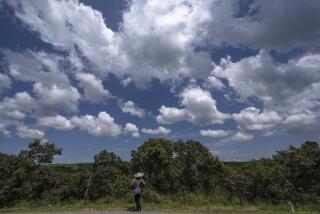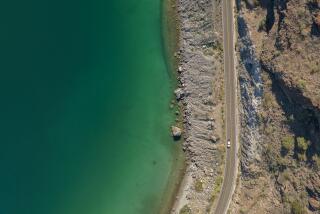By Boat Into the Malaysian Jungle
- Share via
CHINI, Malaysia — The sun was already hot early in the morning when Cheam, my Chinese guide, met me in Kuantan on Malaysia’s east coast to take me to historic Lake Chini.
Legends say that an ancient Khmer city lies buried beneath the giant lake. Villagers believe monsters lurk in the deep waters, guarding the lake.
It’s a one-hour drive to Kampung Belimbing, a small village by the Pakang River, where canoes take travelers to Lake Chini.
Huge shops along the road advertise the salted dried fish for which Kuantan is famous. Hens waddle along the mud-caked sides of the highway with their little chicks in tow. Lush chili plantations flank the road and compete for space with the huge rubber and palm estates.
Just outside the town of Chini we came to one of the many rubber plantations and took a closer look at its huge, graceful palms.
“The trees are slit diagonally halfway down their trunks,” Cheam said, “and the rubber leaks out from the gash into a bowl strapped around the trunk. In this way, 200 trees are ‘tapped’ a day.”
Two-thirds of Malaysia is under tropical rain forests and jungles that are a million years old. One of the richest and most fertile of the rain forests lies just outside Lake Chini. There, elephants roam and a great variety of animals, birds and flora make it their home.
As we drove deeper into the heart of the forest I saw some orang asli (aborigines) crouched by a fire, eating. These aborigines live mostly by hunting and fishing.
“This is where we leave the road,” said Cheam, stopping the Jeep by a lake filled with blossoming pink lotus flowers and water lilies.
Locals describe this area of rain forests and lakes as a “Garden of Eden.” It’s easy to see why. Growing in profusion, trees yield an abundance of papaya, coffee beans, banana, rambutan, mangoes and durian.
After a short walk through the rain forest we reached the shores of Kampong Belimbing. The rest of our journey was by canoe.
Floating down the 2 1/2-mile winding Chini River, one of 13 narrow tributaries that converge upon Lake Chini, we saw nature in the raw.
Towering trees flanked the banks, their giant roots reaching through the undergrowth into the river. Blackened with age, the huge, dark roots stretched in all directions along the river banks solid with lime deposit. Old, gnarled trunks were majestically sculpted.
The river meanders through a thick canopy of lush green vegetation that forms a tunnel over the water.
Through the trees I saw a massive trench. “That’s where a giant python used to live,” Cheam said. “It was a mile long! The British killed it with a cannon during World War II.”
Sometimes elephants cross the tributary. “Don’t go near, if you see one,” Cheam warned. “They’ll attack. It’s the breeding season.”
We continued, weaving through bamboo fish traps that the orang asli had planted across the river. Brown water snakes six feet long skimmed along and a baby crocodile waddled in the mud.
Chameleon-type water snakes took on the same color as the tree roots among which they lived. Water lizards popped their heads up for air and large water caterpillars floated past, their green bodies looking like leaves.
Monkeys swung from tree to tree, stopping to feed on fruit. Zillions of forest flies swarmed around. And it was cool--the trees protected us from the burning sun.
It was eerie as we drifted downriver, surrounded by the jungle. Water dropped through the rain forest with a hollow echo and insects and birds cried everywhere. We even heard the hoot of a rare hornbill.
Suddenly we glided out of darkness, hitting sunshine, and paddled into a massive expanse of water that seemed to stretch eternally. It was Lake Chini.
As we paddled on, we thought that somewhere far beneath may truly be hidden the secret of a lost civilization. Although several archeological diving expeditions over the years have uncovered numerous artifacts, the only way to find the lost city would be to drain the 360-acre lake.
“There’s a side legend to Lake Chini,” Cheam said. “Every year a miraculous stone appears on the surface, and we believe it acts as a buoy to mark the location of the sunken city.”
At the far end of the lake we steered through a minute opening and reached a narrow miniature jetty. Getting out of the canoe, I worked my way gingerly across the tentative pier, half of it submerged in swamp, until I reached the shore and found, buried in the foothills, an aborigine village.
Little more than a clearing in the hills, there were three large huts with thatched roofs and an open spit for roasting food.
Two little children stared at me, then ran away. A middle-aged couple squatted on the veranda of the main hut. The woman was puffing a cigarette, the man smiling toothlessly. He was the chief.
“Selamat datang!” He welcomed me and shook my hand. I gave him a pack of American cigarettes. He was pleased.
At the far end of the clearing stood a dart board, about 20 feet away from us. The chief pointed to the dart board and picked up his blowpipe.
Inserting a dart into a seven-foot steel pole, he raised it to his mouth, inhaled deeply and blew hard. A split second later the dart hit the center of the board.
This dart was used only for practice, but the tips of others used for hunting were painted with poison made from sap.
“The poison keeps its strength for two months,” the chief said. “So we have to be careful where we store it, because of the children.” He cackled and wagged his finger. “I hang it high up on the walls of the hut so they can’t reach it.”
The aborigines were kind and gentle. They introduced their children, let me take photographs and offered me a cigarette wrapped in palm leaf. I puffed it proudly.
Behind us the bold outline of the Chini mountains rose gently to form nine ridges like the scales of a dragon’s back. There are endless tales of dragons in these thick, primeval Malaysian jungles that are the oldest in the world.
“For centuries,” the chief said, “we orang asli who live by the lake have considered this to be the home of the gods and the breeding ground of the naga (dragon). We believe the mountain is formed by the coiling back of a gigantic dragon.”
The ancient pool of Lake Chini has long been awash with legends. It was reported recently that an old man had witnessed the transformation of a snake into a dragon as it leaped from the lake.
It was time to leave. I shook hands with the chief and his wife and said goodby. Although our language had been restricted, I knew we had communicated. For both of us, it was something to remember.
Returning to our canoe, we glided back along the river, passing some orang asli fishing with nets from tiny rafts. They exhibited their day’s catch--a vast quantity of fish.
I saw some monkeys and baboons as we paddled along. Cheam hoped to lure them closer, producing a whistle that he blew loudly.
The monkeys took no notice, but from somewhere deep in the forest a chorus of birds answered his whistle, mimicking the sound.
I saw a couple of blue hornbills before emerging from the jungle. Rare in peninsular Malaysia, they’re more common in Borneo, where the rhinoceros hornbill has become Sarawak’s national emblem.
More to Read
Sign up for The Wild
We’ll help you find the best places to hike, bike and run, as well as the perfect silent spots for meditation and yoga.
You may occasionally receive promotional content from the Los Angeles Times.






